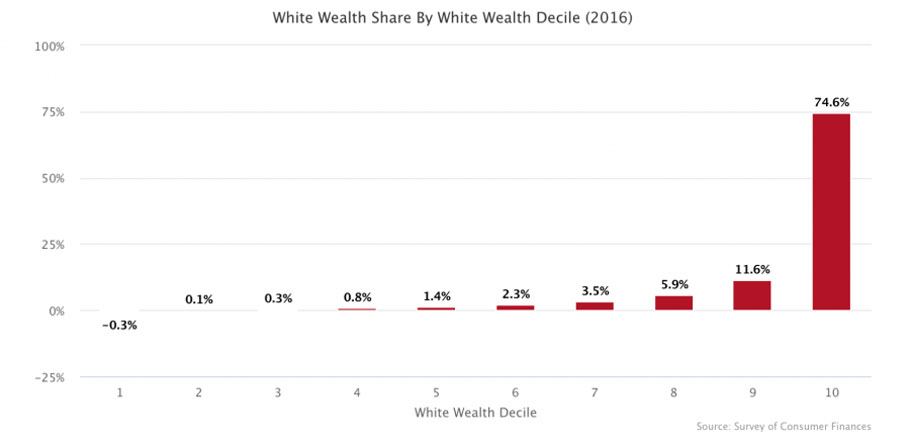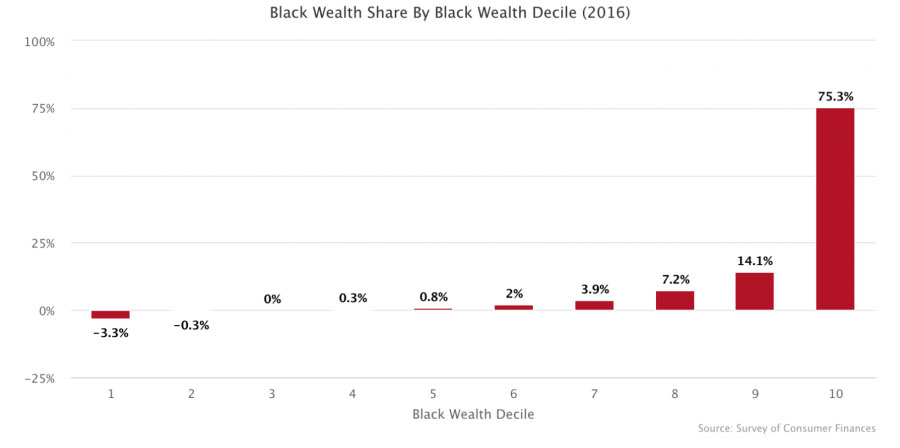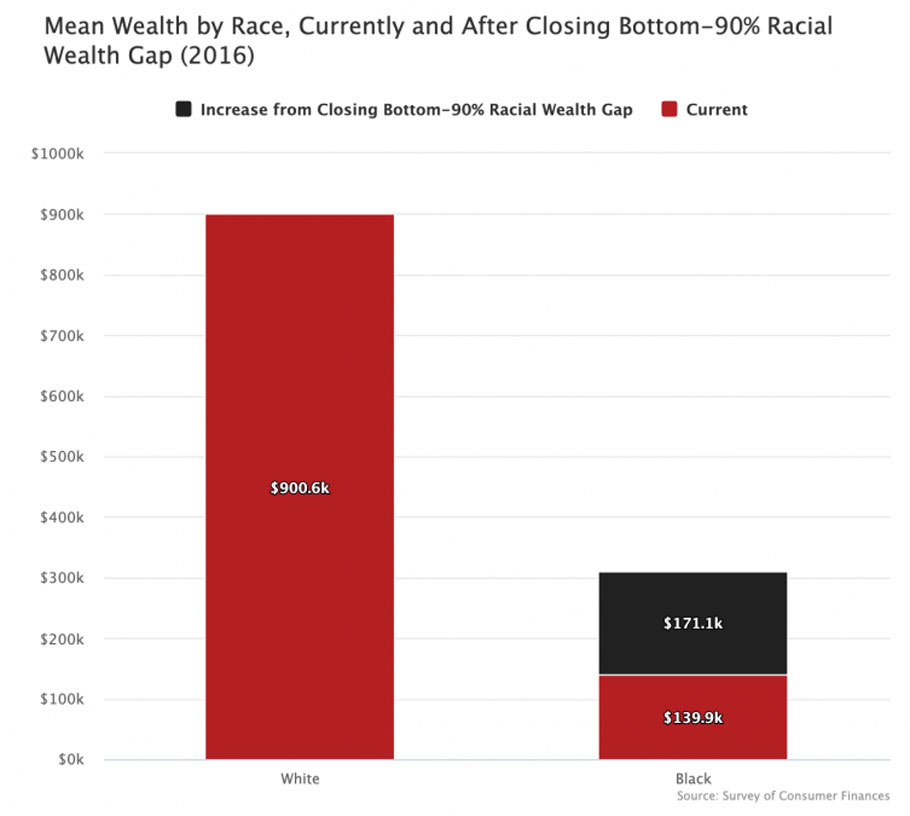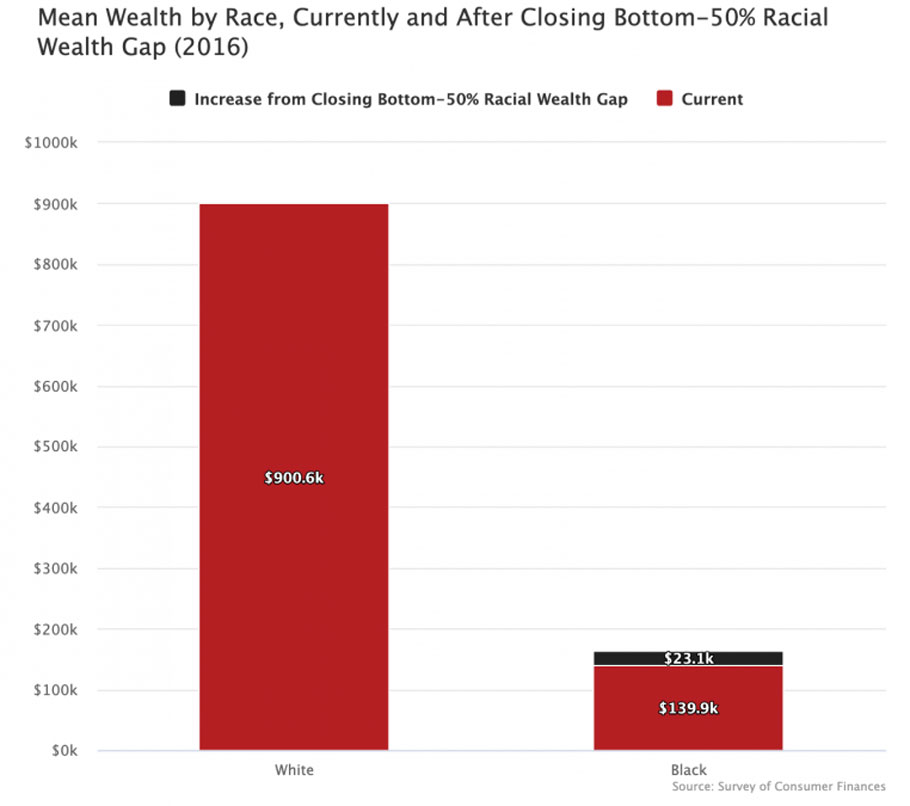Bill Clinton golfing with his wealthy friends on August 5, 2000, in Martha’s Vineyard, MA. (Darren McCollester / Newsmakers)
In light of the recent resurgence of Black Lives Matter protests, there has been renewed discussion of the racial wealth gap and how to close it (Nikole Hannah-Jones, Annie Lowrey). I have written on this topic many times in the past (I, II, III, IV). One thing I have tried to emphasize over the years, which I will do again here in a different way, is that due to the extremely concentrated wealth distribution in the United States, the racial wealth gap is almost entirely about the upper classes in each racial group. I say this not to imply that it is unimportant, but rather because this fact must be grappled with upfront if we are going to make a serious effort to close the racial wealth gap.
If you take the net worth of all white households and divide it by the number of white households, you get $900,600. If you do the same thing for black households, you get $140,000. The difference between these figures — $770,600 — is the best representation of the overall racial wealth gap. That is how much more wealth black people would need per household to have as much wealth as white people have per household.
 But overall statistics can be misleading. If you decompose both of these bars into deciles, what you find is that nearly all white wealth is owned by the top 10 percent of white households just as nearly all black wealth is owned by the top 10 percent of black households. The lower and middle deciles of each racial group own virtually none of their racial group’s wealth.
But overall statistics can be misleading. If you decompose both of these bars into deciles, what you find is that nearly all white wealth is owned by the top 10 percent of white households just as nearly all black wealth is owned by the top 10 percent of black households. The lower and middle deciles of each racial group own virtually none of their racial group’s wealth.

 What this means is that the overall racial wealth disparity is being driven almost entirely by the disparity between the wealthiest 10 percent of white people and the wealthiest 10 percent of black people.
What this means is that the overall racial wealth disparity is being driven almost entirely by the disparity between the wealthiest 10 percent of white people and the wealthiest 10 percent of black people.
One way to illustrate this point (h/t Sam Tobin-Hochstadt) is to see what would happen to the overall racial wealth gap if we entirely closed the wealth gap that exists between the bottom 90 percent of each racial group. Put differently: What would happen to mean black wealth if the bottom 90 percent of black families were given the exact same per-household wealth as the bottom 90 percent of white families?
The answer is that mean black wealth would rise from $140,000 to $311,100. The overall racial wealth gap would thus decline from $760,600 to $589,500, a fall of 22.5 percent. This means that even after you have completely closed the racial wealth gap between the bottom 90 percent of each race, 77.5 percent of the overall racial wealth gap still remains, which is to say that the disparity between the top deciles in each race drives over three-fourths of the racial wealth gap.
 In much of the popular discourse on the racial wealth gap, the emphasis is on the median white household and the median black household. To understand how misguided this emphasis is, we can do exactly what we did above but for the bottom 50 percent of each race. After topping off the current bottom 50 percent of black families so that they have as much wealth per household as the current bottom 50 percent of white families, mean black wealth rises by $23,100, cutting the racial wealth gap by 3 percent.
In much of the popular discourse on the racial wealth gap, the emphasis is on the median white household and the median black household. To understand how misguided this emphasis is, we can do exactly what we did above but for the bottom 50 percent of each race. After topping off the current bottom 50 percent of black families so that they have as much wealth per household as the current bottom 50 percent of white families, mean black wealth rises by $23,100, cutting the racial wealth gap by 3 percent.
 What this shows is that 97 percent of the overall racial wealth gap is driven by households above the median of each racial group. This explains why you can produce shocking conclusions that show a relatively small amount of money can dramatically reduce the (median) racial wealth difference: it is not that hard to get two groups who own relatively little to own the same amount of relatively little. But such measures would not make much of a dent in the overall racial wealth gap.
What this shows is that 97 percent of the overall racial wealth gap is driven by households above the median of each racial group. This explains why you can produce shocking conclusions that show a relatively small amount of money can dramatically reduce the (median) racial wealth difference: it is not that hard to get two groups who own relatively little to own the same amount of relatively little. But such measures would not make much of a dent in the overall racial wealth gap.
In my mind, this information should force us to be more clear about what exactly we are trying to achieve when we talk about closing the racial wealth gap. If we are trying to make the black wealth distribution match the white wealth distribution, then fixing the racial wealth gap mostly involves redistributing a lot of wealth between the white and black upper classes. That’s where the wealth is, and so that’s where the wealth gap is.
If we are just trying to make it so the “everyday black family” (defined by the median) looks like the “everyday white family,” then that costs very little (0.5 percent of the national wealth) because it ignores all the people who own meaningful amounts of wealth.
Both ideas seem a bit ridiculous in different ways, the first idea because it’s essentially a squabble between the upper classes, the second idea because it does nothing to really cut down on overall racial wealth inequality. The way through this bind is, of course, to acknowledge that racial capitalism has concentrated almost all of the national wealth in the hands of a small number of white families and that the proper course of action is to redistribute that wealth to the multiracial lower and working classes, tackling both racial and class inequality simultaneously.
Source: Jacobin














